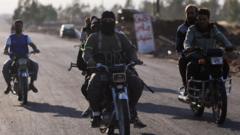On June 17, 2025, Iran and Israel have entered the fifth day of intense military exchanges, leading to rising civilian fatalities and mass evacuations in Tehran as President Trump suggests seeking a definitive end to the conflict. The violence poses grave implications for both nations and highlights the challenges for citizens caught in the crossfire.
**Escalating Conflict: A Climate of Fear and Uncertainty in Tehran Amid Military Strikes**

**Escalating Conflict: A Climate of Fear and Uncertainty in Tehran Amid Military Strikes**
As the Israel-Iran conflict intensifies, fear grips Tehran residents, with reports of civilian casualties mounting on both sides.
---
**Title:** Escalating Conflict: A Climate of Fear and Uncertainty in Tehran Amid Military Strikes
**Description:** As the Israel-Iran conflict intensifies, fear grips Tehran residents, with reports of civilian casualties mounting on both sides.
**Summary:** On June 17, 2025, Iran and Israel have entered the fifth day of intense military exchanges, leading to rising civilian fatalities and mass evacuations in Tehran as President Trump suggests seeking a definitive end to the conflict. The violence poses grave implications for both nations and highlights the challenges for citizens caught in the crossfire.
The ongoing military conflict between Iran and Israel has escalated, marking its fifth consecutive day of violent exchanges as fears mount among civilians in both nations. President Trump returned to Washington, D.C., amid the heightened tensions, emphasizing the need for a resolution "better than a ceasefire."
Reports indicate significant casualties as Iranian attacks reportedly resulted in at least 224 deaths and over 1,400 injuries, while the Israeli side has faced 24 fatalities and around 600 injuries from retaliatory strikes. The situation intensified as the Israeli military announced the death of Maj. Gen. Ali Shadmani, the highest-ranking military commander in Iran, just days into the conflict.
With homes under threat from missile strikes, Tehran residents are facing mass panic. Some have opted to evacuate, creating chaotic scenes at gas stations and on highways. The Iranian government has confirmed shortages in fuel and disruption to internet services, making it challenging for families to seek refuge.
A deep sense of uncertainty lingers among citizens like Meisam, who expressed frustration with the lack of clear evacuation routes, stating, “Where should I go? Where can I go?” Cities like Tehran, heavily populated, are now witnessing the crumbling of social order—ordinary citizens feeling trapped and unable to escape the violence.
As the Group of 7 nations urge for de-escalation, American military support remains crucial to the unfolding dynamics in the region. However, discussions around diplomacy have become increasingly complex, with Iran's foreign ministry hinting at possible negotiations amidst ongoing missile launches.
The conflict threatens not only local stability but could exacerbate broader geopolitical tensions, as the specter of military escalation looms large. Authorities on both sides grapple with the impacts on civilians, caught in a cycle of retaliation and violence, prompting urgent calls for humanitarian considerations as the world watches closely.
**Title:** Escalating Conflict: A Climate of Fear and Uncertainty in Tehran Amid Military Strikes
**Description:** As the Israel-Iran conflict intensifies, fear grips Tehran residents, with reports of civilian casualties mounting on both sides.
**Summary:** On June 17, 2025, Iran and Israel have entered the fifth day of intense military exchanges, leading to rising civilian fatalities and mass evacuations in Tehran as President Trump suggests seeking a definitive end to the conflict. The violence poses grave implications for both nations and highlights the challenges for citizens caught in the crossfire.
The ongoing military conflict between Iran and Israel has escalated, marking its fifth consecutive day of violent exchanges as fears mount among civilians in both nations. President Trump returned to Washington, D.C., amid the heightened tensions, emphasizing the need for a resolution "better than a ceasefire."
Reports indicate significant casualties as Iranian attacks reportedly resulted in at least 224 deaths and over 1,400 injuries, while the Israeli side has faced 24 fatalities and around 600 injuries from retaliatory strikes. The situation intensified as the Israeli military announced the death of Maj. Gen. Ali Shadmani, the highest-ranking military commander in Iran, just days into the conflict.
With homes under threat from missile strikes, Tehran residents are facing mass panic. Some have opted to evacuate, creating chaotic scenes at gas stations and on highways. The Iranian government has confirmed shortages in fuel and disruption to internet services, making it challenging for families to seek refuge.
A deep sense of uncertainty lingers among citizens like Meisam, who expressed frustration with the lack of clear evacuation routes, stating, “Where should I go? Where can I go?” Cities like Tehran, heavily populated, are now witnessing the crumbling of social order—ordinary citizens feeling trapped and unable to escape the violence.
As the Group of 7 nations urge for de-escalation, American military support remains crucial to the unfolding dynamics in the region. However, discussions around diplomacy have become increasingly complex, with Iran's foreign ministry hinting at possible negotiations amidst ongoing missile launches.
The conflict threatens not only local stability but could exacerbate broader geopolitical tensions, as the specter of military escalation looms large. Authorities on both sides grapple with the impacts on civilians, caught in a cycle of retaliation and violence, prompting urgent calls for humanitarian considerations as the world watches closely.





















